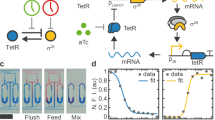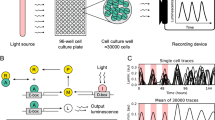Abstract
Circadian clocks consist of three elements: entrainment pathways (inputs), the mechanism generating the rhythmicity (oscillator), and the output pathways that control the circadian rhythms. It is difficult to assign molecular clock components to any one of these elements. Experiments show that inputs can be circadianly regulated1,2,3 and outputs can feed back on the oscillator4,5. Mathematical simulations indicate that under- or overexpression of a gene product can result in arrhythmicity, whether the protein is part of the oscillator or substantially part of a rhythmically expressed input pathway6. To distinguish between these two possibilities, we used traditional circadian entrainment protocols7,8 on a genetic model system, Neurospora crassa.
This is a preview of subscription content, access via your institution
Access options
Subscribe to this journal
Receive 51 print issues and online access
$199.00 per year
only $3.90 per issue
Buy this article
- Purchase on Springer Link
- Instant access to full article PDF
Prices may be subject to local taxes which are calculated during checkout




Similar content being viewed by others
References
Emery, P., So, WV., Kaneko, M., Hall, J. C. & Rosbash, M. CRY, a Drosophila clock and light-regulated cryptochrome, is a major contributor to circadian rhythm resetting and photosensitivity. Cell 95, 669–679 (1998).
Roenneberg, T. & Deng, T.-S. Photobiology of the Gonyaulax circadian system: I Different phase response curves for red and blue light. Planta 202, 494–501 (1997).
Roenneberg, T. & Foster, R. G. Twilight times—light and the circadian system. Photochem. Photobiol. 66, 549–561 (1997).
Block, G., Geusz, M., Khalsa, S., Michel, S. & Whitmore, D. (eds). Cellular Analysis of a Molluscan Retinal Biological Clock 51–66 (Wiley, Chichester, (1995).
Mrosovsky, N., Salmon, P. A., Menaker, M. & Ralph, M. R. Nonphotic phase shifting in hamster clock mutants. J. Biol. Rhythms 7, 41–50 (1992).
Roenneberg, T. & Merrow, M. Molecular circadian oscillators—an alternative hypothesis. J. Biol. Rhythms 13, 167–179 (1998).
Aschoff, J. (ed.) Biological Rhythms(Plenum, New York, (1981).
Aschoff, J. in Proc. XIII Int. Conf. Soc. Chronobiol. (Pavia 1977)(Halberg, F.et al., eds) 105–112 (Il Ponte, Milan, (1981).
Bruce, V. Environmental entrainment of circadian rhythms. Cold Spring Harbor Symp. Quant. Biol. 25, 29–48 (1960).
Aronson, B. D., Johnson, K. A., Loros, J. J. & Dunlap, J. C. Negative feedback defining a circadian clock: autoregulation of the clock gene frequency. Science 263, 1578–1584 (1994).
Garceau, N. Y., Liu, Y., Loros, J. J. & Dunlap, J. Alternative initiation of translation and time specific phosphorylation yield multiple forms of essential clock protein FREQUENCY. Cell 89, 469–476 (1997).
Crosthwaite, S. K., Loros, J. J. & Dunlap, J. C. Light-induced resetting of a circadian clock is mediated by a rapid increase in frequency transcript. Cell 81, 1003–1012 (1995).
Loros, J. J. & Feldman, J. F. Loss of temperature compensation of circadian period length in the frq -9 mutant of Neurospora crassa. J. Biol. Rhythms 1, 187–198 (1986).
Aronson, B. D., Johnson, K. A. & Dunlap, J. C. The circadian clock locus frequency : a single ORF defines period length and temperature compensation. Proc. Natl Acad. Sci. USA 91, 7683–7687 (1994).
Feldman, J. F. & Hoyle, M. N. Isolation of circadian clock mutants of Neurospora crassa. Genetics 75, 605–613 (1973).
Merrow, M. W. & Dunlap, J. C. Intergeneric complementation of a circadian rhythmicity defect: phylogenetic conservation of structure and function of the clock gene frequency. EMBO J. 13, 2257–2266 (1994).
Somers, D. E., Webb, A. A., Pearson, M. & Kay, S. A. The short-period mutant, toc1-1, alters circadian clock regulation of multiple outputs throughout development in Arabidopsis thaliana. Development 125, 485–494 (1998).
Crosthwaite, S. K., Dunlap, J. C. & Loros, J. J. Neurospora wc-1 and wc-2 : Transcription, photoresponses, and the origin of circadian rhythmicity. Science 276, 763–769 (1997).
Russo, V. E. Blue light induces circadian rhythms in the bd mutant of Neurospora : double mutants bd,wc-1 and bd,wc-2 are blind. J. Photochem. Photobiol. B 2, 59–65 (1988).
Liu, Y., Merrow, M., Loros, J. L. & Dunlap, J. C. How temperature changes reset a circadian oscillator. Science 281, 825–829 (1998).
Merrow, M., Garceau, N. & Dunlap, J. Dissection of a circadian oscillation into discrete domains. Proc. Natl Acad. Sci. USA 94, 3877–3882 (1997).
Sargent, M. L., Briggs, W. R. & Woodward, D. O. Circadian nature of a rhythm expressed by an invertaseless strain of Neurospora crassa. Plant Physiol. 41, 1343–1349 (1956).
Winfree, A. T. Suppressing Drosophila circadian rhythm with dim light. Science 183, 970–972 (1974).
Arpaia, G., Loros, J. J., Dunlap, J. C., Morelli, G. & Macino, G. The interplay of light and the circadian clock. Plant Physiol. 102, 1299–1305 (1993).
Chang, B. & Nakashima, H. Effects of light-dark cycles on the circadian conidiation rhythm in Neurospora crassa. J. Plant Res. 110, 449–453 (1997).
Dharmananda, S. Studies of the Circadian Clock of Neurospora crassa: Light-Induced Phase Shifting (University of California, Santa Cruz, (1980).
Lakin-Thomas, P. L. Choline depletion, frq mutations, and temperature compensation of the circadian rhythm in Neurospora crassa. J. Biol. Rhythms 13, 268–277 (1998).
Thresher, R. J. et al. Role of mouse cryptochrome blue-light photoreceptor in circadian photoresponses. Science 282, 1490–1494 (1998).
Stanewsky, R. et al. The cryb mutation identifies cryptochrome as a circadian photoreceptor in Drosophila. Cell 95, 681–692 (1998).
Roenneberg, T. & Taylor, W. Automated Recordings of Bioluminescence—with special reference to the analysis of circadian rhythms. Methods Enzymol. 305(in the press).
Acknowledgements
This work is dedicated to the memory of J. Aschoff. We thank V. Schiewe, A. Kohnert and G. Meyer for excellent technical assistance; the members of the Woody Hastings lab for comments on the manuscript; and the DFG, the Meyer-Struckmann-Stiftung and the Münchner Medizinische Wochenschrift for support.
Author information
Authors and Affiliations
Corresponding authors
Rights and permissions
About this article
Cite this article
Merrow, M., Brunner, M. & Roenneberg, T. Assignment of circadian function for the Neurospora clock gene frequency. Nature 399, 584–586 (1999). https://doi.org/10.1038/21190
Received:
Accepted:
Issue Date:
DOI: https://doi.org/10.1038/21190
This article is cited by
-
Effects of circadian clock and light on melatonin concentration in Hypericum perforatum L. (St. John’s Wort)
Botanical Studies (2020)
-
Multiple random phosphorylations in clock proteins provide long delays and switches
Scientific Reports (2020)
-
Diel patterns in space use, food and metabolic activity of Galaxias maculatus (Pisces: Galaxiidae) in the littoral zone of a shallow Patagonian lake
Aquatic Ecology (2013)
-
Peroxiredoxins are conserved markers of circadian rhythms
Nature (2012)
Comments
By submitting a comment you agree to abide by our Terms and Community Guidelines. If you find something abusive or that does not comply with our terms or guidelines please flag it as inappropriate.



